by Contributed | Nov 16, 2020 | Technology
This article is contributed. See the original author and article here.
Azure Cloud Advocates at Microsoft are pleased to offer a 12-week, 24-lesson curriculum all about JavaScript, CSS, and HTML basics. Each lesson includes pre- and post-lesson quizzes, written instructions to complete the lesson, a solution, an assignment and more. Our project-based pedagogy allows you to learn while building, a proven way for new skills to ‘stick’.
See more at: https://github.com/microsoft/Web-Dev-For-Beginners
Content Round Up
Datacenter Migration & Azure Migrate – Sarah Lean
Sarah Lean
In this Skylines Summer Session, Sarah Lean, #Microsoft #Cloud Advocate, is interviewed by Richard Hooper and Gregor Suttie and discusses
How to setup and run Azure Cloud Shell locally
Pierre Roman
Scripts running in Azure Cloud Shell can exceed the 20 minute timeout. Learn how to run it locally to avoid this restriction.
CODE Magazine – Project Tye: Creating Microservices in a .NET Way
Shayne Boyer
Project Tye: Creating Microservices in a .NET Way
Azure Stack Hub Partner Solutions Series – RFC
Thomas Maurer
This week in our Azure Stack Hub Partner solution video series, I am going to introduce you to Azure Stack Hub Partner RFC.
microsoft/Web-Dev-For-Beginners
Yohan Lasorsa
24 Lessons, 12 Weeks, Get Started as a Web Developer – microsoft/Web-Dev-For-Beginners
Introduction to #WebXR with Ayşegül Yönet
Aysegul Yonet
? WebXR is the latest evolution in the exploration of virtual and augmented realities. Sounds interesting, right? Dive into the Basics of WebXR with Ayşegül…
Connect your React app to Microsoft 365
Waldek Mastykarz
With the Microsoft Graph Toolkit, you’ll be able to connect your app to Microsoft 365 in a matter of minutes. Here is how you’d do it.
Debug Node.js app with built-in or VS Code debugger
Yohan Lasorsa
Learn how to use built-in or VS Code debugger to fix bugs in your Node.js apps more efficiently with this series of bite-sized videos for beginners.
Microsoft 365 PnP Weekly – Episode 104 – Microsoft 365 Developer Blog
Waldek Mastykarz
Connect to the latest conferences, trainings, and blog posts for Microsoft 365, Office client, and SharePoint developers. Join the Microsoft 365 Developer Program.
How to build an audit Azure Policy with multiple parameters
Sonia Cuff
Learn how to build an audit mode Azure Policy, to show resources that don’t have all of your required tags.
Azure Functions via GitHub Actions with No Publish Profile
Justin Yoo
Throughout this series, I’m going to show how an Azure Functions instance can map APEX domains, add an SSL certificate and update its public inbound IP
Deploy to GitHub Packages With GitHub Actions | LINQ to Fail
Aaron Powell
Let’s look at how to automate releases to GitHub Packages using GitHub Actions
DevOps and Machine Learning, with Henk Boelman
Henk Boelman
DevOps and Machine Learning, with Henk Boelman – Codecamp_The One with DevOps 2020 With machine learning becoming more and more an engineering problem the ne…
C# Corner Azure Learning and Microsoft Certification – AMA ft. Thomas Maurer
Thomas Maurer
Last week I had the honor to be a guest in the C# Corner Live AMA (Ask Me Anything) about Azure Learning and Microsoft Certification.
Azure Functions – Tartine & Tech
Yohan Lasorsa
Les Azure functions font partie de la stack Server less d’Azure. Dans cet épisode, Yohan vous explique en quoi ça consiste et comment créer votre premier pro…
OpenAPI Extension to Support Azure Functions V1
Justin Yoo
This post shows how Azure Functions v3 runtime works as a proxy to Azure Functions v1 runtime, to enable the Open API extension.
Wayve | Disrupting Autonomous Driving
Adi Polak
Join us for an exceptional conversation with Alex Kendall, co-founder, and CEO of Wayve, who raised more than 40M$ to kickstart the biggest vehicle academy.
Using Immutable Objects with SQLite-Net
Brandon Minnick
SQLite-NET has become the most popular database, especially amongst Xamarin developers, but it hasn’t supported Immutable Objects, until now! Thanks to Init-Only Properties in C#9.0, we can now use Immutable Objects with our SQLite database!
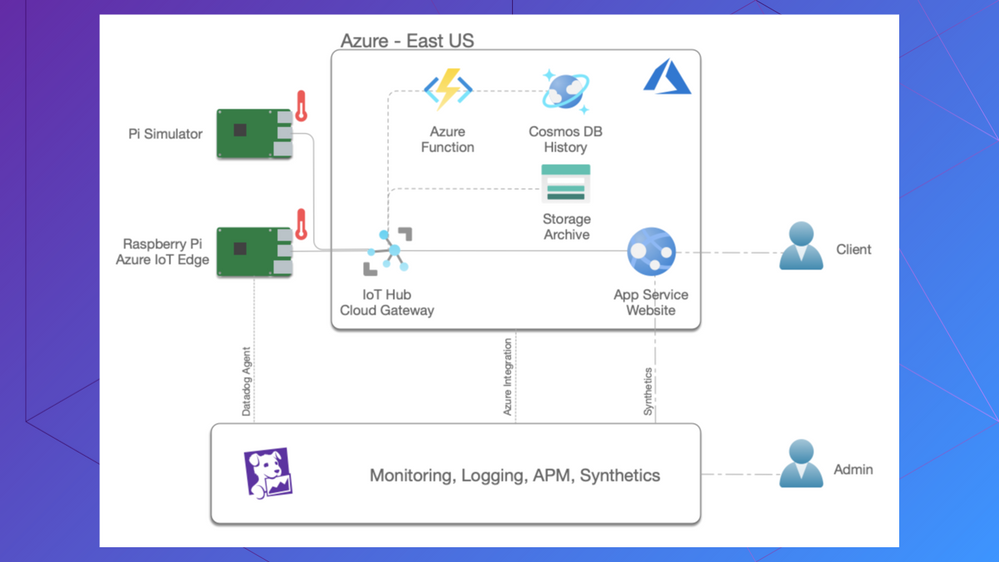
by Contributed | Nov 16, 2020 | Technology
This article is contributed. See the original author and article here.
Microsoft Azure has a strong and active partnership with Datadog, the leading cloud-based monitoring and observability platform. Recently, Datadog and Azure teamed up to significantly reduce latency in the collection of Azure Monitor metrics, and they also collaborated on a streamlined, first-of-its-kind experience for purchasing, configuring, and managing Datadog directly inside the Azure portal.
Azure has emerged as the industry leader in delivering IoT solutions in a powerful and scalable platform, but as organizations migrate to IoT environments, their infrastructure—from the edge to the cloud—becomes more complex. Datadog’s tight integration with the Azure IoT ecosystem enables users to gain better visibility into this environment at every layer.
Datadog achieves this unparalleled visibility into the Azure IoT environment with a lightweight Agent, which is deployed to Linux or Window-based devices. This Agent collects over one hundred system health metrics and provides an interface to send custom metrics to Datadog, allowing device operators to track KPIs specific to their applications. Datadog’s Azure integration also comes equipped with out-of-the-box dashboards for popular Azure IoT services and more including CosmosDB, Functions, and Azure DevOps, so users can quickly identify the root cause of any bottlenecks in processing and serving data. In a recent webinar, we showcase exactly how the Datadog monitoring suite can allow you to monitor all aspects of your Azure IoT solution from device to cloud, using an example solution based on the resources depicted in the architecture diagram below.

To learn more about Datadog’s integration with Azure IoT and related services, we invite you to check out our recent webinar featuring Jimmy Caputo and Ryan MacLean of the Datadog team as they are joined by Paul DeCarlo from Microsoft. The presentation features a live demonstration of the Datadog agent running on an IoT device instrumented with Azure IoT Edge to show how you can leverage this pairing to operate large-scale IoT Device fleets confidently. To get started visit this link or click on the image below to register for this on-demand session.
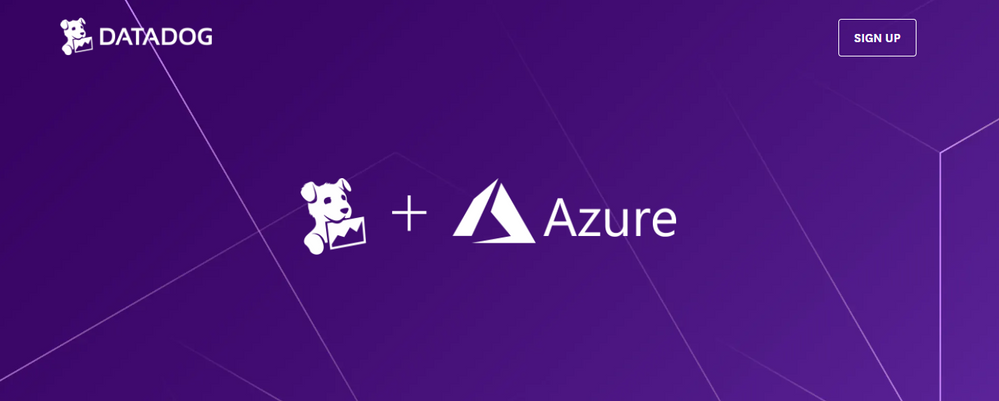

by Contributed | Nov 16, 2020 | Technology
This article is contributed. See the original author and article here.

Register Now.. https://allaroundazuredevguideai.splashthat.com/
Content For The sessions
Learning Path: Developer’s Guide to Artificial Intelligence
A learning path is a carefully curated set of technical sessions that provide a view into a particular area of Azure; and often help you prepare for a certification. Each session in a learning path is business-scenario focused so you can see how this technology could be used in the real world. Each session is independent, however viewing them as a series builds a clearer picture of when and how to use which technology. Artificial Intelligence (AI) is driving innovative solutions across all industries but with machine learning (ML) applying a paradigm change to how we approach building products we are all exploring how to expand our skill sets and enhance our applications. Tailwind Traders is a retail company looking for support on how to benefit from applying AI across their business. In ‘Developer’s Guide to AI’ we’ll show how Tailwind Traders have solved business challenges and implemented AI technologies. In this learning path you will see a wide range of examples: dealing with different types of data (text, audio, image, unstructured), sharing best practices around unstructured search and conversational AI or taking your next step in learning more about machine learning theory with low code solutions.
Session 1: Introducing Computer Vision for Automation in Changing Times
In an effort to protect the wellbeing and safety of all employees during the global pandemic and promote social distancing, Tailwind Traders needed to reconsider its staffing model. This has presented a challenge; quarterly inventory counts are happening in 4 weeks time and a reduction in staff means a longer inventory count period. In this session you will learn how Computer Vision was harnessed to address this opportunity and enable inventory counts to occur quicker to aid workers using Azure Cognitive services vision capabilities. Key technologies included: Cognitive Services Computer Vision, ONNX, Unity Check out more on Learn!
Session 2: Extracting Value from Text and Audio to Inform Business Strategy
Tailwind Traders have a great website and application for customers and partners. However, they are seeing an increased amount of support tickets regarding usage of these offerings. They want to store, analyze and extract insights from their text and audio data to make better product backlog decisions and reduce their support tickets. In this session you’ll learn how Tailwind Traders took their support ticket text and audio files, convert and extract insight metadata from each ticket using Azure Cognitive Services Text Analytics and Speech-to-Text. Then aggregated their findings to inform their product backlog and implement improvements. Key technologies included: Azure Cognitive Services, Azure Storage and Power BI, (Aspect Based Sentiment Analysis, Speech to Text, LUIS) Check out more on Learn!
Session 3: Making Sense of your Unstructured Data with AI
Tailwind Traders have a lot of data often in unreadable formats such as Invoice PDFs, Product and Review images and inventory forms. They would like the ability to extract this rich information, analyze it and act on it. In this session, you’ll learn how the team use Azure Cognitive Search to make sense of this data in a short amount of time and with amazing success. We’ll discuss AI concepts, like the ingest-enrich-explore pattern, skillsets, leveraging cognitive services, knowledge bases and connecting all these elements together to build an intelligent search experience into their applications. Key technologies included: Azure Cognitive Search, Azure Cognitive Services, Azure Functions, Azure Storage. Check out more on Learn!
Session 4: Improve Customer Engagement and Productivity with Conversational AI
Tailwind Traders recent internal employee survey showed their employees are frustrated with lengthy processes for simple actions, such as booking vacation and other company benefits. They want to reduce the friction of reviewing and booking vacation so it’s a simple, easy and pleasant process for their employees. In this session you will see how Tailwind Traders applied Conversational AI best practices to simplify the vacation process for their employees. Using the Bot Framework Composer tooling you can quickly build conversation flows, incorporate intelligence services such as Q&A maker and LUIS, test and deploy your virtual assistant to the cloud and embed it where your customers and employees spend their time. Key technologies included: Bot Framework – Composer, Cognitive Services – Q&A Maker, Cognitive Services – LUIS, Azure Bot Service Teams. Check out more on Learn!
Session 5: Start Building Machine Learning Models Faster than You Think
Tailwind Traders are finding it difficult to accurately predict they inventory at their many different retail stores. They want to introduce custom machine learning models to help, without changing their Software Development Life Cycle. How? They are exploring Azure Machine Learning Designer. In this session, you’ll learn the data science process that Tailwind Traders’ uses and get an introduction to Azure Machine Learning Designer. You’ll see how to find, import, and prepare data, select a machine learning algorithm, train and test the model, and deploy a complete model to an API. Get tips, best practices, and resources you and your development team need to continue your machine learning journey. Key technologies included: Azure Machine Learning Designer. Check out more on Learn!

by Contributed | Nov 16, 2020 | Technology
This article is contributed. See the original author and article here.
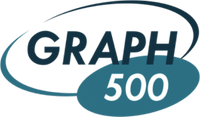
The Azure HPC team is proud to join the Top 20 list in the Graph500 ranking announced at the Supercomputing 2020 Conference. We used Azure HBv2 VM instances for our Graph500 run, achieving 1152 GTEPS (Giga Traversed Edges Per Seconds) for the Graph500 Breadth First Search kernel. This resulted in Azure ranking 17th all-time on the Graph500. To the best of our knowledge, this is the first public cloud cluster entry in Graph500 ranking list.
Graph500 Benchmark:
Graphs are one of the most ubiquitous models in analytical workloads. They are powerful representations of many types of relations and process dynamics. They are used various scientific and engineering fields like medical informatics, social networks, symbolic networks, financial applications, cyber security, etc. Basic graph algorithms such as breadth-first search, depth-first search, shortest path, minimum spanning tree, etc. are key components in many modern real-life applications.
The Graph500 benchmark is designed to represent data intensive and irregular applications that use graph algorithm-based processing methods. Further, it is used to evaluate the scalability of supercomputing clusters in the context of data-intensive applications with irregular communication characteristics. The Graph500 benchmark stresses hardware and runtime systems by forcing massive amounts of communication and synchronization thereby modeling more realistic application workloads. Graph500 Consists of two sets of benchmarks – Search (Breadth First Search) and Shortest Path. We used the BFS benchmark for this submission.
Submission Details:
We used 640 Azure HBv2 VM instances for this Graph500 experiment. HBv2 VM instances offer 200 gigabits per second HDR InfiniBand networking that enables Graph500 benchmark to efficiently scale across hundreds of compute nodes. Each HBv2 VM features 120 AMD EPYC™ 7002-series CPU cores with clock frequencies up to 3.3 GHz, 480 GB of RAM, 350 GB/s of memory bandwidth, and a large L3 cache of 480 MB. The System and Benchmark Configuration that we used are depicted below:
System Configuration:
- 640 x Azure HBv2 VMs (AMD “Rome” 7V12, 2.45-3.3 GHz, 480 GB of RAM)
- Operating System: CentOS-HPC 7.7
- Network: InfiniBand HDR 200 Gbps
- MPI Library: HPC-X
Benchmark Configuration:
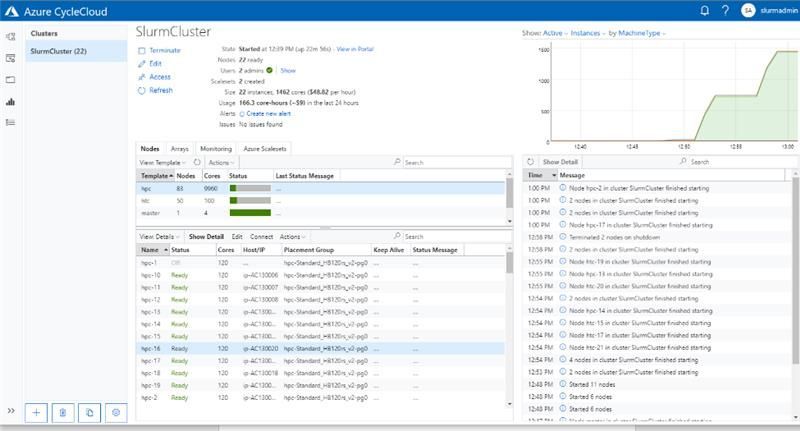
by Contributed | Nov 16, 2020 | Technology
This article is contributed. See the original author and article here.
Since March of this year, Microsoft has been a member of the COVID-19 HPC Consortium formed between government agencies, universities, and the private sector, to provide HPC resources to researchers around the world for advancing COVID-19 and SARS-CoV-2 research. Collectively, the consortium is making over 480 petaflops of computing resources freely available to researchers around the world on a priority basis. This unprecedented collaboration of the most advanced computing organizations from across the world is united with the singular purpose of overcoming one of the most challenging public health crises of the last hundred years.
To date, Microsoft AI for Health has funded 19 COVID-related projects through the Consortium, providing HPC systems built on Azure Virtual Machines and Storage services, and HPE Cray XC technologies. With the simplicity of the Azure CycleCloud HPC orchestrator, coupled with an easy to deploy yet performant managed file system with Azure NetApp Files, we can stamp out extremely capable HPC systems running the Slurm scheduler and provide them to researchers around the world for COVID-19 research. The research teams utilize these Azure HPC systems the same way they would with any supercomputing facility.

The Slurm cluster deployed using Azure CycleCloud, utilized by Duke University for performing ventilator airflow simulations
These systems have been used for projects like molecular simulations of viral proteins with the Folding@Home team, designing split ventilator systems to aid hospital treatments in times of patient surge by a team from Duke University, and the pharmaceutical company UCB contributing to the COVID Moonshot project, identifying novel compounds with antiviral properties.
One of the key computational workloads for advancing COVID-19 research is molecular dynamics (MD), where interactions of atoms in a molecular complex are simulated as trajectories through time. MD provides a starting point for predicting the stability of molecular structures, which is critical for identifying compounds are viral protein inhibitors. It is also useful for vaccine design, where scientists simulate the efficacy of small protein fragments binding to receptors on white-blood cells.
NAMD (Nanoscale Molecular Dynamics), developed by a team of biophysicists and computer scientists at the University of Illinois at Urbana Champaign (UIUC), uses the Charm++ library for parallelization and is known for its ability to run at extremely largely scale, including the full size of some of the world’s largest supercomputers. Researchers run NAMD in supercomputing facilities where they can utilize hundreds or even thousands of compute servers to simulate large molecular structures. NAMD has been referred to as “The Computational Microscope” for its ability to deliver insights that are not possible in an experimental lab setting.
One such example of a molecular system is the SARS-Cov2 Spike Proteins on the viral envelop. This simulation, funded through the Covid-19 HPC Consortium and running on Azure HPC systems, provides a glimpse into this vital component of the viral machinery.
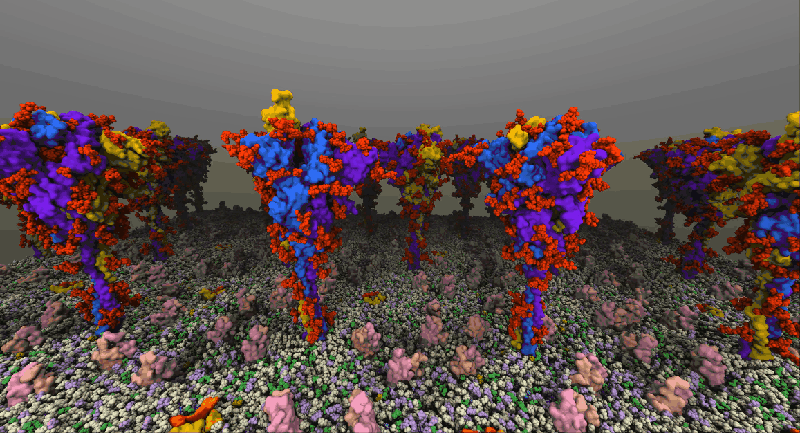
NAMD simulation of membrane-bound Spike proteins, courtesy of UIUC
Azure has been partnering with the NAMD team at UIUC to understand how far NAMD can scale on Azure’s infrastructure, as it helps us provide guidance to researchers seeking resources for MD simulations including those related to COVID-19 research. We focused the benchmarking on the Azure HBv2 VMs that offer 200 gigabits per second HDR InfiniBand networking and enables NAMD to efficiently scale across hundreds of compute nodes and many tens of thousands of parallel processes. Each HBv2 VM also features 120 AMD EPYC™ 7002-series CPU cores with clock frequencies up to 3.3 GHz, 480 GB of RAM, 350 GB/s of memory bandwidth, and a large L3 cache of 480 MB.
The figure below shows strong scaling results for NAMD on 20 million atom and 210 million atom STMV matrix systems, a standard synthetic benchmarking model based on the Satellite Tobacco Mosaic Virus (STMV). NAMD was built with the Charm++ runtime and the UCX communication layer. The benchmark uses version 2.14 of NAMD without any special runtime optimizations or algorithmic and code changes.
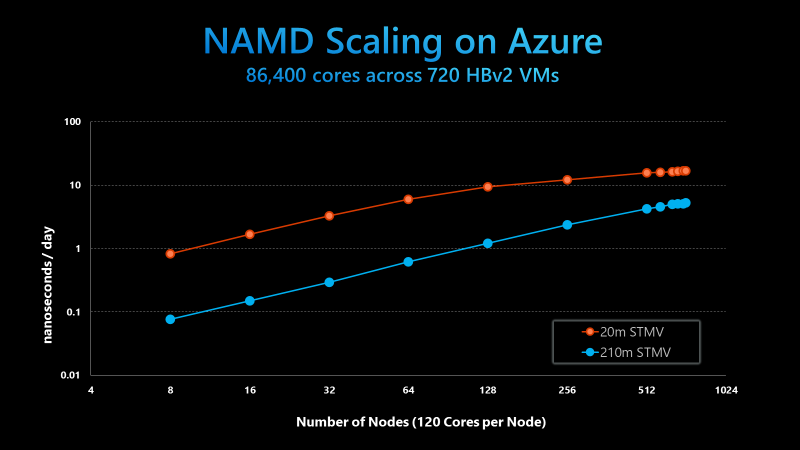
NAMD 2.14 scaling on Azure HB120rs_V2 VMs, using the 20m and 210m STMV models
While the 20 million atom system is not large enough to linearly scale past 256 nodes, the 210 million atom system scales well up to 720 nodes. In doing so, the Azure and UIUC teams completed the largest scale HPC simulation ever on the public cloud, scaling NAMD across 86,400 parallel cores. This is an order of magnitude higher than anything demonstrated previously.
Comparing the benchmarking results achieved on Azure with the equivalent published for the Frontera system, the National Science Foundation’s leadership-class supercomputer and #8 in the world, Azure HPC capabilities are now in league with the best supercomputing facilities available. It is truly remarkable that researchers can now turn to a public cloud resource that offers true supercomputing capabilities. They can now run larger-scale models at a higher fidelity, and for longer timescales, as they pursue critical results for time sensitive research, demonstrating Azure’s supercomputing scale and performance for addressing the most challenging scientific and engineering problems of our times.






Recent Comments